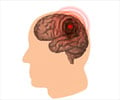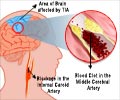A 40 percent decrease in the incidence of stroke has been found in a new analysis of data from 1988- 2008 in Medicare patients 65 years of age or older.

"Shedding light on trends in the burden of stroke among Medicare beneficiaries may provide important information for policy purposes, including describing the past and current scope of the condition, assessing the potential effect of stroke prevention interventions on a national level, and identifying areas where resources can be targeted more specifically and effectively," says lead investigator Margaret C. Fang, MD, MPH, an Associate Professor of Medicine at the University of California San Francisco School of Medicine, who also serves as the Medical Director of the UCSF Anticoagulation Clinic.
The study was constructed to analyze stroke cases over the past two decades, not to investigate causation; however, researchers did find evolving patterns in the risk factors associated with strokes. Although the prevalence of diabetes mellitus increased over time, other risk factors, such as cigarette smoking, measured systolic blood pressure, and total cholesterol values, decreased.
The decline in stroke rates paralleled increasing use of antihypertensive and statin medications and might explain the reduction in stroke rates. "Antihypertensive medications reduce the risk of stroke by approximately 32% and statins by approximately 21%. Stroke rates seem to decrease most sharply after year 1998, approximately when statin use became more prevalent," explains Dr. Fang. "If true, then this illustrates how medical interventions have resulted in significant improvements in health on a population level."
Investigators analyzed occurrence data from a sample of Medicare patients diagnosed as having suffered a stroke. Risk factors such as high blood pressure, diabetes, smoking status, and high lipid levels were gathered from the National Health and Nutrition Examination Survey (NHANES). The Medicare Current Beneficiary Survey was used to determine medication use.
The team identified more than one million stroke events from 1988 to 2008, of which 87.3% were ischemic and 12.7% hemorrhagic strokes. The analysis showed a reduction in ischemic strokes from 927 per 100,000 in 1988 to just 545 per 100,000 in 2008. Hemorrhagic strokes decreased from 112 per 100,000 to 94 per 100,000 over the same time period, primarily among men.
Advertisement
Dr. Fang notes that "Our analysis confirms the continuing and devastating effect of hemorrhagic stroke, but was unable to assess for casual factors influencing mortality rates; relatively few interventions have been shown to reduce stroke-related mortality. Timely administration of intravenous thrombolytics is associated with more favorable outcomes from ischemic stroke, but has not been shown to have significant effects on mortality. In addition, the rate of thrombolytic administration continues to be low in the United States."
Advertisement















